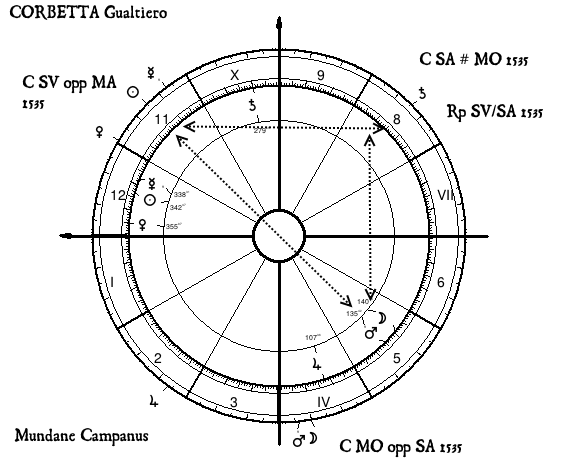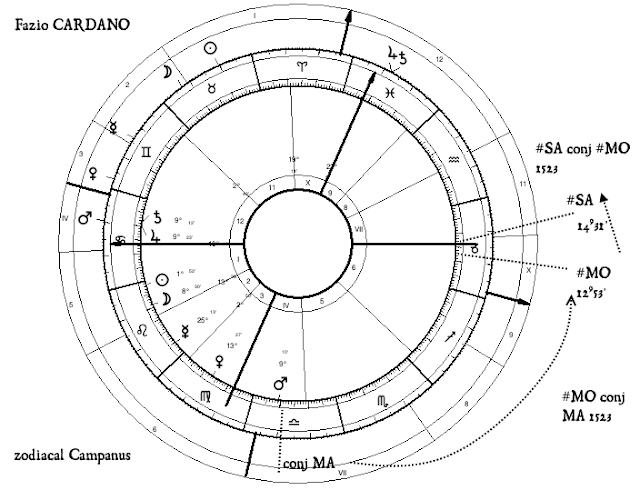HIERONYMI CARDANI - DE EXEMPLIS CENTUM GENITURARUM
IV
CARDANO Fazio
1)- introduction
The year of birth of Fazio Cardano is incertain: 1444 or 1445? We are therefore placed in a situation where we must make a bet on the validity of the rules of astrology. We will therefore consider the two occurrences and establish a diagnosis of presumption. In any case, Jérôme Cardan gave the theme of his father in De exemplis Centum Geniturarum [in opera omnia, vol. 5, p. 460] and in
Hieronymi Cardani medici Mediolalnensis, Libelli quinque [p. 106] : july 25, 1445 (Gregorian) at 8h40 AM (i.e. 3h20).
My father Fazio was a jurisconsult. My grandfather was Antonio, my great-grandfather another Fazio, my grcat-great-grandfather, Aldo. The first Fazio, my great-grandfather, had three sons: Giovanni, Aldo II and Antonio who became my grandfather. The sons of Antonio were Got-tardo, Paolo, a jurisconsult and prelate, Fazio, my father, and an illegitimate son named Paolo. Now there are alive, from the same family, almost thirty kinsmen. Whether, however, the family of the Cardani is a line in itself, or whether, as certain people think, it is a branch of the Castiglioni, surely it has been both noble and ancient. From the year 1189 a Milonc Cardano was prefect of Milan for seven years and eight months by the ecclesiastical as well as the civil calendar. And he presided not only at civil suits, but even, like other Chiefs of State, at criminal trials; he had charge, also, of cases in other cities which were under Milanese jurisdiction; and cases throughout the whole region. Among these cities was Como. Milone had secured this high post of honor through the Archbishop Crivelli when the latter had been hurriedly advanced to the Pontificate as Pope Urban III.
There are those who would like to have it that Francesco Cardano, leader of the military troop of Matteo Visconti, belongs to our branch of the family. If we arc a branch of the Castiglioni, however, we are still more illustrious because of Pope Celestino IV who sprang from this same stock.
All our forebears have, moreover, been longevous. The sons of the first Fazio lived ninety-four, eighty-eight and eighty-six years. The two sons of Giovanni, my great-uncle, were Antonio, who lived eighty-eight years, and Angiolo who lived ninety-six years. As a boy I saw this decrepit old man. Giacomo, an only son of the second Aldo, passed seventy-two years. Gottardo, my paternal uncle, lived eighty-four years, and him also I saw. My father lived eighty years. That cousin Angiolo, the one who reached his ninety-sixth year, begot sons—infants feeble as if with their father’s senility—even when he himself was in his eightieth year, and after his eightieth year he recovered his sight. The eldest of these sons has lived to be seventy, and I hear that some of his children became giants; indeed, I saw some of them long ago.
There were, besides, from the family of the Micheri (my mother Chiara’s family), my grandfather Giacomo, who lived seventy-five years and his brother Angiolo who was in his eighty-fifth year when I was a little boy. He himself told me so. [excerpt from
De Vita propria liber (The Book of my life), translates by Jean Staner 1929.]
2)- natal chart
The natal chart is characterized by a close conjunction VE-SA (I), ASC CANCER (ruler MO VI); SU I. But I do not see
how this aspect of the sky could be compatible with a life as long as
that of Fazio.The primary directions seem to indicate a death nearly 30 years... If we consider the year 1444, the aspect of the natal chart changes completely.
Let us therefore
assume that Fazio was born in 1444, which seems accredited by many
documents (but Cardano compute the geniture for 1445 ...).
- ASC CANCER, ruler MO (I) and SU (I).
- MC PISCES, ruler JU (CANCER), conj. SA
- ALMUTEN (Morinus) : MO
So, MO is ALCHOCODEN and ALMUTEN ; SU is HYLEG. ANAERETE is MA.
We have two major dates for Fazio, including that of his meeting with his wife, Girolamo's mother. It was about 1498: Fazio was then 53 years old. The other date is that of his death: 1524.
3) primary directions
A)- 1498
We have to compute the parallel rapt MO || JU which occurs around 52 years. This is the very type of direction that occurs when forming a couple. This was the case for Fazio, since he lived in concubinage with Chiara Micheri, future mother of Girolamo. Morinus finds Rp MO || VE at 53.8 ° (PTO), corresponding to 1498.
Here we see all the Rp between MO and VE for the three types of domitude. We have computed this RP according to the MO motion (2.201° for 52 years) and to the latitude of MO.
Note that we
have another way of calculating rapt-parallel: mean that the designer of
Morinus seems to have used, by reference to the algorithms of
Makranski: it is to consider VE as significator and to direct ASC as
promissor. And we find therefore :
| C Regio Campa |
47,116 |
| D Placidus |
53,228 |
| D Regio Campa |
53,228 |
| C Placidus |
45,06 |
Recall : Morinus 53.8° for Placidus. We find 56.46° with Campa and 53.19 with Regio (PTO).
B)- 1524
At the time of the death of Fazio, two world divisions are in orb: C MA conj MO and C VE conj. SA.
1)- compute MA conj MO
a) - parameters
b)- results
As you can see, we have only one direction that is compatible with the date. From mundane regio-Campa 76.98°. And the date is actually 1523.73. However, I must point out that these results are not complete. The
following table supplements these incomplete data, not so much because
of the method employed as for the formulation of the orb and the keys
employed.
c) reflections about results
As we see the orb of the key AR is tightened significantly [0.99-1.01]. If
we practice, by way of example, the analysis of this direction without
latitude, we obtain the following table, quite different:
The absence of latitude leads to a shift of the aspects below the key of Ptolemy.
2)-#MO conj MA
The zodiacal
directions are marked by a converse conjunction of #MO to MA and
especially rarely, by a conjunction of two #, due to the Moon's proper motion: #MO conj #SA.
Let's see the first direction:
- parameters
- results
We observe two arcs of direction in mundane Placidus.
3)- compute #MO conj #SA
Take MO = 12°53'17' SAGIT and SA = 15°29'07" SAGIT ; sum L MO and proper motion : 3.261. You will havean arc of D = 0.6° between MO and SA. So, it is a true secondary direction by proper motion of MO.


















































